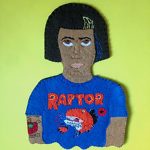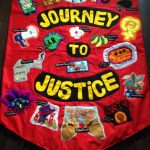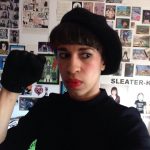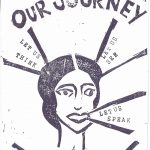19 Jun Meet the Artist: Seleena Laverne Daye
View Seleena’s Craftivism video & making tutorials on the Making for Change Expo here.
Seleena Laverne Daye is a self-taught artist, born in Bradford and raised in Manchester. She is a textile artist and makes works primarily out of felt and using traditional techniques such as embroidery and cross stitch. Seleena has also been making zines since the age of 15.
Her work features topics relating to race, class, sexuality and gender whilst being heavily inspired by ’90s popular culture. Skill sharing is an important factor for Seleena in making art accessible, and she regularly delivers workshops from zine making, to embroidery. Seleena is also a part of the artists’ collective Yiiikes!, Poor Lass Zine a zine and podcast telling the stories of working class people, and Over Here, a collective creating spaces for creatives of colour.
For Making for Change Expo, Seleena has been creating some brilliant guides, showing you how you craft your own zine, how to decide the subject, and sharing some of the history of how zines developed. We caught up with Seleena to get to know her and her work, see how she’s been doing through lockdown and finally seek her advice for anyone wanting to be more creative.
Do you have any tips for coping with your wellbeing or creativity during lockdown?
I’m learning as I go along, like most people, on how to stay well during lockdown. I’m a part time artist/ workshop facilitator and part time retail worker, with a few extra hobbies too thrown in, so I’m generally a busy person who never stops, even when I need to.
I’m currently not working at my retail job and my art based work has slowed down a little, so I’m using this time to tell myself it’s ok to sometimes just do NOTHING, which I struggle with, but your artistic worth isn’t and should never be measured by your creative output, that’s a capitalist approach to art.
I’m also slowly picking up creative projects I haven’t had time for recently, things I do for fun, like crochet or zine making and staying active with walks and tap dancing.
I guess in short, it’s about balance and not feeling bad for not doing anything and taking the things I am doing slowly and having fun doing them!
Do you have a project you are particularly proud of?
A lot of the recent work I am really proud of is the collaborative stuff that comes out of the workshops I facilitate. I have made a few banners about the oppression POC face as well as POC who inspire and empower us, it’s always great to see what workshop attendees create and then what it looks like when it’s put together. More recently I have had the pleasure of helping to create zines by some really important migrant women groups, which I love to do as I learn so much and love being able to create a space for the women to share their story in their own words.
The project I created alone that I’m most proud of is probably my solo exhibition I did in 2016. Entitled What, Is She Black Now? Named after some already existing works. It was the first exhibition I arranged, booked the venue, paid for and promoted all myself. It also encouraged me to make a lot of new work and try different mediums as well as show some older work. It featured one of my favourite pieces I have made, which is a Brownies sash with embroidered patches on it, all containing statements and questions I have been asked by white people, which often leave me exhausted and bored. It was a fun way of showing the monotony and rudeness of comments I can get, sometimes daily, about my race. I feel like it summed up the whole theme of the exhibition well too.
Do you have any advice for young people starting out in a creative career?
I know it’s been said time and time again, but my advice to anyone starting out is JUST DO IT!
It took me many years before I fully realised I could turn some of my creative practices in to more of a career. Imposter syndrome is a big thing amongst many creatives and is something I have from time to time. I’m a self-taught artist with no qualifications above a GCSE and my only creative ones were in dance and textiles. So for many years I felt as a working class uneducated creative person, I couldn’t call myself an artist. There’s often a mapped out journey for artists which is they study art and find a way into the art world, but I believe anyone could and should be allowed to create, privilege shouldn’t be a way to measure your artistic worth.
My artistic career is not my full time job, as it isn’t with many creative people I know. That isn’t a shortcoming on your behalf if you find you can’t go full time in your artistic endeavour. Stick with it if you can, and make sure that you are enjoying it.
You can find out more about Seleena’s work over on her website here , or on social media via @seleenalavernedaye. If you want to get crafty, watch her recent animation on making a one-page zine. Make sure you check out the expo to download her zine guides!
Image Credit: Seleena Laverne Daye






